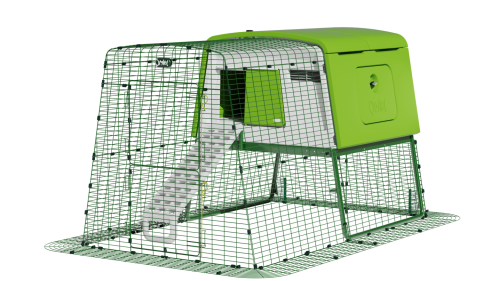
Collecting tasty, fresh eggs from the Omlet Eglu Pro Chicken Coop.
One of the most common things for a chicken keeper to ponder is how many eggs their hens will produce. This could be a daily, weekly, seasonal, or even lifelong expectation that’s determined by a hen’s genetics. Some chickens are bred to be prolific egg layers, while others are more of an ornamental bird meant to add a touch of whimsy to a flock. Either way, all chickens lay eggs – but if you’re looking for “good” egg-laying breeds, look no further than these egg-laying extraordinaires.
The science behind good egg-layers
If all hens lay eggs, why are some more proficient at it than others? The simple answer is: genetics. Over the ages, breeds have been crossed in an effort to increase egg production. The resulting breeds that we consider “good” egg-layers today can be expected to lay around 250 eggs per year. In comparison, ornamental chicken breeds like Silkies or Polish only lay around 120 and 150 eggs per year respectively. The general rule of thumb is that a good laying hen will lay one egg every day and a half.
All hens go through various laying stages throughout their lives, with their most prolific laying years being their first and second, with a slow decline in yearly numbers thereafter. There are several things your hens’ eggs can tell you about their health, with egg production being a very good indicator of diet and environmental health. Even good-laying breeds will dramatically decrease or even stop laying eggs during their annual molting cycle, which takes place in mid-late fall. But, as long as you support your hens through a molt, they’ll be back to laying their expected egg numbers – even during the winter months.
The best egg-laying chicken breeds
All hens may lay eggs, but some stand out above the rest when it comes to annual egg production. The following breeds are known for their egg-laying prowess, and can easily supply your family with fresh eggs all year round.
Leghorns
Leghorn hens can produce between 280-320 eggs per year, making them the highest egg-laying breed on average. In fact, the title of the highest authenticated number of eggs laid in a year by a single hen is held by a White Leghorn. In 1979, this particular hen laid 371 eggs in 365 days. These hardy hens rarely go broody, and provide large white eggs year-round.
Hybrids
Hybrids are chickens that have been crossed with several different breeds – usually with the intention of increasing a specific trait like meat, egg production, or appearance. As a result, several hybrid breeds are prolific egg-layers, averaging around 280 eggs per year. Among hybrid egg-layers, Isa Browns stand out as top producers, capable of laying up to 350 eggs per year.
Australorps
On average, Australorp hens lay around 250 eggs per year. But, an Australorp hen was documented to have laid 364 eggs in 365 days, earning this breed a solid top spot when it comes to good egg layers.
Rhode Island Reds
Rhode Island Red chickens are popular backyard flock members due to their availability, reliability, and adaptability. Laying between 200-300 eggs per year, a Rhode Island Red hen is an excellent choice for those looking to increase their daily egg-collecting numbers.
Plymouth Rocks
As a large breed, Plymouth Rocks also lay up to 280 large eggs per year. The traditional “barred” color makes them a unique addition to a flock, provided they have enough space. Regular egg collection is required for these big birds, as they do have a healthy drive to go broody.
Sussex
Sussex hens have long been prized for both their looks and their egg-laying ability. They can lay up to 260 eggs per year, and are not prone to going broody. Their eggs are cream to light brown in color, and the speckled variety of Sussex hens are particularly beautiful to see in a backyard.
Are there “bad” egg-laying breeds?
Good egg-laying breeds don’t have a direct opposite. Instead, chickens are grouped into one of the following categories:
- Layers
- Boilers(or meat chickens)
- Dual-purpose
- Ornamental
Since all chickens lay eggs, it’s not fair to say that some breeds are “bad” layers. Just as laying breeds were bred to increase their egg production, others have been bred to enhance another aspect. Boiler and dual-purpose chickens are bred for weight and rapid growth, while ornamental chickens have been selectively bred to attain a specific size, color, feather pattern or texture.
All classifications of chickens lay eggs, but their production is dependent upon their genetics. By keeping a variety of chicken breeds, you’ll be able to experience everything each has to offer while keeping a steady supply of eggs for your family.
Omlet and your egg-layers
All hens lay eggs, and all hens need a secure chicken coop to call home. With dedicated nesting areas, optional automatic chicken coop doors, and supplemental weather covers for chicken coops, our line of chicken products work as hard as your hens while reducing your workload. By keeping your flock safe and comfortable all year round, you’ll ensure their happiness and by extension, their egg production.





Comments
There are no comments just yet